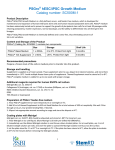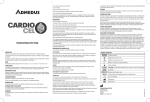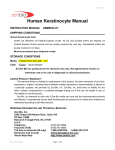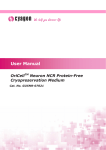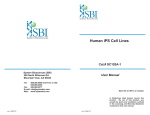Download Human Foreskin Fibroblast Cell Lines
Transcript
Human Foreskin Fibroblast Cell Lines (Neonatal and pooled) Cat.# PC501A/B-HFF User Manual Store kit at -80 C on receipt A limited-use label license covers this product. By use of this product, you accept the terms and conditions outlined in the Licensing and Warranty Statement contained in this user manual. ver. 091012-1 Human Foreskin Fibroblasts, neonatal Cat. # PC501A/502B HFFn Contents I. Human Foreskin Fibroblasts, neonatal (HFFn)…..……...2 A. Description….……...…..……...…..……...…..…….…...…..……...2 B. Maintenance of HFFn…..……...…..…….....……...…..……….….2 C. Morphology of HFFn in Culture…..…….....…..……...…..……...4 D. References…..……...…..……...…..……...…..…….…...…..……...4 E. Technical Support…..……...…..……...…..……...…..…….…...…4 II. Licensing and Warranty Statement…………………………..5 List of Components The Human Foreskin Fibroblasts, neonatal (HFFn), are available as cryopreserved cells in one vial. PC501A-HFF is optimized for the usage as iPS source cells, whereas PC502BHFF is optimized for the usage as feeder cells. PC501A-1 PC502B-1 HFFn, One Vial HFFn, One Vial 6 1x10 cells 6 1x10 cells The cryopreserved HFFn cells are shipped on dry ice and should be immediately stored in liquid nitrogen upon receipt. Properly stored cells are stable for more than 2 years from the date received. 888-266-5066 (Toll Free) 650-968-2200 (outside US) Page 1 System Biosciences (SBI) I User Manual Human Foreskin Fibroblasts, neonatal A. Description Human foreskin fibroblasts, neonatal (HFFn, cat# PC501A-HFF and PC502B-HFF) were isolated from neonatal foreskin. Each vial of this product contains 1X106 viable cells. In our laboratory, each lot of cells is performance tested by culturing the cells through multiple passages in the absence of antibiotics and antimycotics, no contamination was observed during this culture period. Upon thawing, the cells are guaranteed to be >75% viable and have a potential of >30 population doublings when cultured according to the instructions provided in this manual. B. Maintenance of HFFn Cultures Initiating Cultures from Cryopreserved Cells To insure the highest level of viability, be sure to warm medium to 37 °C before using it on the cells. We recommend seeding cells recovered from cryoperservation at a cell density of 4 x 103 viable cells/cm2. The procedure given below is a sample protocol for establishing cultures from the contents of one vial. 1. Prepare a bottle of DMEM supplemented with 10% heat-inactivated FBS with/without antibiotics. 2. Remove the vial from liquid nitrogen storage, taking care to protect hands and eyes. 3. Dip the lower half of the vial into a 37°C water bath to thaw. 4. When the contents of the vial have thawed, wipe the outside of the vial with 75% alcohol to disinfect and move the vial to a laminar flow culture hood. 5. Open the vial and pipet the cell suspension up and transfer the cells into a 15-cm conical tube with 10 ml fresh culture medium. 6. Pipet up and down with a 10 ml pipette to disperse the cells and centrifuge the cells at 180 g for 5 minutes. Observe the cell pellet. 7. Remove the supernatant form the tube, being careful not to dislodge the cell pellet. 8. Resuspend the cell pellet with fresh culture medium and seed new culture vessels with 4 x 3 2 10 cells/cm . 9. Incubate the cultures in a 37 °C, 5% CO2 /95% airhumidified cell culture incubator. 10. Do not disturb the culture for at least 24 hours after the culture has been initiated. Maintaining Stock Cultures 1. Change the culture medium 24 to 36 hours after establishing the secondary culture from cryopreserved cells. 2. Change the medium every other day thereafter, until the culture is approximately 80~90% confluent. Subculturing HFFn 1. Remove all of the culture medium from the T75 flask. 2. Washing cells with 10 ml pre-warmed DPBS once. 3. Add 3 ml of 0.25% trypsin-EDTA solution to the flask. Rock the flask to ensure that the entire surfaced is covered. 4. Incubate the flask at room temperature until the cells have become round, approximately 2~4 minutes. View the culture frequently under a microscope to avoid over digestion. 5. Add 7 ml of culture medium to the flask and transfer the detached cells to a sterile 15 ml conical tube. 6. Centrifuge the cells at 180 g for 5 minutes. 7. Remove the supernatant from the tube, being careful not to dislodge the cell pellet. Page 2 ver. 1-090701 www.systembio.com Human Foreskin Fibroblasts, neonatal Cat. # PC501A/502B HFFn 8. Resuspend the cells pellet in 10 ml supplemented medium. Pipet the cells up and down with a 10 ml pipette to ensure a homogeneous cell suspension. 9. Determine the concentration of cells in the suspension. 3 2 10. Seed new culture vessels with 4 x 10 cells/cm , or 1 to 3~5 split if starting cells at a 90% confluence. 11. Incubate the cultures in a 37 °C, 5% CO2 /95% air humidified cell culture incubator. Cryopreserving HFFn 1. Follow steps 1-6 from the Subculturing of Cells above. 2. Resuspend the cell pellet in culture medium. Add approximately 1 ml for each T75 flask. 3. Count the number of cells and dilute the cell suspension to 2 x 106 cells/ml. 4. Add an equal volume of cold 2X Freezing Media to the cell suspension. 5. Aliquot 1 ml of suspension into each cryovial (1 x 106 cells/vial). 6. Place the vials in a cell-freezing container and keep it at -80 °C overnight. 7. Transfer the vials to a liquid nitrogen tank for long-term storage. Note: We recommend to use DMEM supplement with 20% FBS and 10% DMSO as freezing media to cryopreserve HFF cells. 888-266-5066 (Toll Free) 650-968-2200 (outside US) Page 3 System Biosciences (SBI) User Manual C. Morphology of HFFn in Culture -----------------------------------------------------------------------------------------HFFn cells grown in DMEM supplemented with 10% FBS without antibiotics. Images of HFFn in culture after thaw. Day1 –HFFn Day 3 –HFFn Day 5 -HFFn ---------------------------------------------------------------------------------------------------- D. References Takahashi, K. and Yamanaka, S. 2006. Induction of pluripotent stem cells from mouse embryonic and adult fibroblast cultures by defined factors. Cell 126: 663–676. Takahashi K. et al. 2007. Induction of pluripotent stem cells from adult human fibroblasts by defined factors. Cell. 131: 861–72. Park, IH et al. 2008. Reprogramming of human somatic cells to pluripotency with defined factors. Nature. 451:141–6. E. Technical Support For more information about SBI products and to download manuals in PDF format, please visit our web site: http://www.systembio.com For additional information or technical assistance, please call or email us at: System Biosciences (SBI) 1616 North Shoreline Blvd. Mountain View, CA 94043 Phone: (650) 968-2200 (888) 266-5066 (Toll Free) Fax: (650) 968-2277 E-mail: General Information: [email protected] Technical Support: [email protected] Ordering Information: [email protected] Page 4 ver. 1-090701 www.systembio.com Human Foreskin Fibroblasts, neonatal II. Cat. # PC501A/502B HFFn Licensing and Warranty Statement Limited Use License Use of the human foreskin fibroblasts (i.e., the “Product”) is subject to the following terms and conditions. If the terms and conditions are not acceptable, return all components of the Product to System Biosciences (SBI) within 7 calendar days. Purchase and use of any part of the Product constitutes acceptance of the above terms. The purchaser of the Product is granted a limited license to use the Product under the following terms and conditions: • • • The Product shall be used by the purchaser for internal research purposes only. The Product is expressly not designed, intended, or warranted for use in humans or for therapeutic or diagnostic use. The Product may not be resold, modified for resale, or used to manufacture commercial products without prior written consent of SBI. This Product should be used in accordance with the NIH guidelines developed for stem cell research. SBI has pending patent applications related to the Product. For information concerning licenses for commercial use, contact SBI. Purchase of the product does not grant any rights or license for use other than those explicitly listed in this Licensing and Warranty Statement. Use of the Product for any use other than described expressly herein may be covered by patents or subject to rights other than those mentioned. SBI disclaims any and all responsibility for injury or damage which may be caused by the failure of the buyer or any other person to use the Product in accordance with the terms and conditions outlined herein. Limited Warranty SBI warrants that the Product meets the specifications described in this manual. If it is proven to the satisfaction of SBI that the Product fails to meet these specifications, SBI will replace the Product or provide the purchaser with a refund. This limited warranty shall not extend to anyone other than the original purchaser of the Product. Notice of nonconforming products must be made to SBI within 30 days of receipt of the Product. SBI’s liability is expressly limited to replacement of Product or a refund limited to the actual purchase price. SBI’s liability does not extend to any damages arising from use or improper use of the Product, or losses associated with the use of additional materials or reagents. This limited warranty is the sole and exclusive warranty. SBI does not provide any other warranties of any kind, expressed or implied, including the merchantability or fitness of the Product for a particular purpose. SBI is committed to providing our customers with high-quality products. If you should have any questions or concerns about any SBI products, please contact us at (888) 266-5066. © 2009 System Biosciences (SBI). 888-266-5066 (Toll Free) 650-968-2200 (outside US) Page 5








